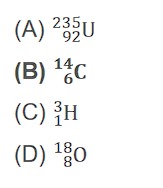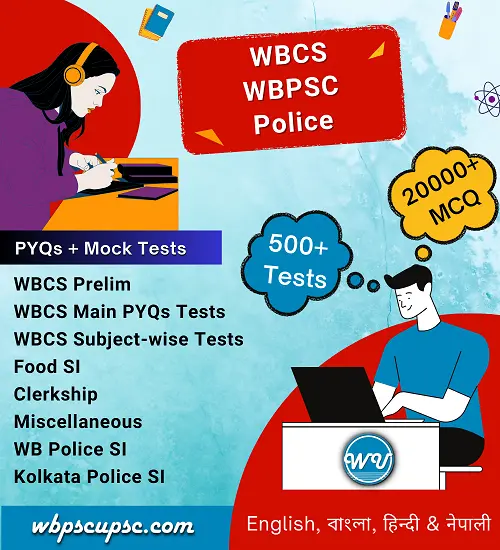(A) absorbed.
(C) may be absorbed or released depending upon the specific heat of the liquid.
(D) neither absorbed nor released.
60. Identify the substance which can dissolve in water:
100. Mg (s) +O2(g) –> MgO (s) + energy, this reaction may be classified as a/an
(A) White precipitation of lead iodide is formed.
(C) Red precipitation of lead iodide is formed.
(D) Black precipitation of lead iodide is formed.
(A) sp sp3
(B) sp2 sp
(C) sp2 sp2
(D) sp sp
(Hydrofluoric acid)
(A) HNO3
(B) HCl
(C) HF
(D) HBr
(Atomic weight : Na = 23, 0 = 16, H = l)
(A) 2
(B) 20
(C) 4
(D) 1
(A) Acetyl salicylic acid
(B) Sodium salicylate
(C) Methyl salicylate
(D) Ethyl salicylate
WBCS Preliminary Question – 2014
(A) Platinum
(B) Silver
(C) lron
(D) Gold
(Noble gas)
(A) Helium
(B) Neon
(C) Argon
(D) Xenon
(Na2CO3)
(A) Sodium carbonate
(B) Calcium carbonate
(C) Sodium bicarbonate
(D) Sodium hydroxide
167. The half-life period of an isotope is 2 hours. After 6 hours what fraction of the initial quantity of the isotope will be left behind ? (radioactive decay)
(A) 1/6
(B) 1/3
(C) 1/8
(D) 1/4
(A) Zero
(B) One
(C) Two
(D) Three
WBCS Preliminary Question – 2013
48. One of the breakthrough of Acharya P. C. Roy was to synthesize the following compound : (Ammonium nitrite, 1896)
(A) HgCl2
(B) NH4NO2
(C) Hg2Cl2
(D) H2O4
(Hard Water)
(A) K
(B) Ca
(C) As
(D) Fe
(HCL, spirits of salt)
(A) Acetic acid
(B) Hydrochloric acid
(C) Oxalic acid
(D) Aqua regia
(A) Mg++
(B) Fe++
(C) Al+++
(D) Mn++
(Phenyl – C6H5)
(A) Methyl alcohol
(B) Tartaric acid
(C) Benzene
(D) Anthracene
(Dichlorodiphenyltrichloroethane)
(A) Air only
(B) Air and soil only
(C) Air, soil and water only
(D) Air and water only
190. ‘Higgs Boson’ is :
(God particle)
(A) Name of a film
(B) An elementary particle
(C) Generic name of a medicine
(D) Planet
WBCS Preliminary Question – 2012
(A) 5.20
(B) 4.80
(C) 5.80
(D) 4.85
167. How many grams of dibasic acid (mol wt 200) should be present in 100 ml of its aqueous solution to give 0.1(N) strength ? (A) 2 gm
(B) 1gm
(C) 10 gm
(D) 20 gm
(polyvinyl chloride)
(A) Rubber
(B) Nylon 6-6
(C) PVC
(D) Bakelite
(detecting peptide bonds)
(A) Molish’s test
(B) Biuret test
(C) DNP test
(D) Benedict’s test
WBCS Preliminary Question – 2011
95. Vulcanisation is the process of heating rubber with 3 – 5% of (synthetic rubber)
(A) Sulphur
(B) Lime
(C) Potassium permanganate
(D) Naphthalene
(refrigerants – CFC & HCFC)
(A) Nitrogen dioxide
(B) Sulphur dioxide
(C) Freon
(D) Chlorine nitrate
(substitutional alloy)
(A) Iron and Copper
(B) Copper and Tin
(C) Copper and Aluminium
(D) Copper and Zinc
(PAN – C2H3NO5)
(A) Peroxyacetyl nitrate
(B) Nitrogen monoxide
(C) Ultra violet rays
(D) Hydrocarbon
WBCS Preliminary Question – 2010
(A) Uranium 238
(B) Plutonium 239
(C) Neptunium 239
(D) Thorium 236
(CH4, Compressed natural gas)
(A) Petrol
(B) Alcoholic fuel
(C) CNG
(D) Diesel
WBCS Preliminary Question – 2009
34. At constant temperature if the pressure decreases, then the volume of a given mass of gas will (Boyle’s law)
(A) Increase
(B) Decrease
(C) Remain constant
(D) May increase or decrease depending on nature of the gas
54. Normal saline is an aqueous solution of sodium chloride of strength (A) 0.84 % (0.9%)
(B) 1.00 normal
(C) 1.00 molar
(D) 1 %
(A) An allotrope of carbon
(B) A synonym for carborundum
(C) Artificial emery
(D) A compound of carbo
(A) Nuclear fusion
(B) Spallation
(C) Nuclear fission
(D) Nuclear isomerisatio
WBCS Preliminary Question – 2008
(A) Progression
(B) Regression
(C) Sublimation
(D) Repression
(A) Malic acid
(B) Formic acid
(C) Iso-citric acid
(D) Fumeric acid
(A) Arsenic
(B) Bismuth
(C) Lead
(D) Tin
WBCS Preliminary Question – 2007
32.
Neutron was discovered by
(1930)
(A) J. Chadwick
(B) J.J Thomson
(C) Rutherford
(D Neil Bohr
(A) FeSO4 ,7H2O
(B) ZnSO4 ,7H2O
(C) MgSO4 ,7H2,O
(D) CuSO4 ,5H2O
(A) Hot dil. NSO4
(B) cold dil. HNO3
(C) Fuming HNO3
(D) None of the above
(A) 0
(B) –1/2
(C) -1
(D) +2
(A) Good conductor of heat
(B) High density
(C) Good Conductor of electricity
(D) High coefficient of expansion
(A) emulsion
(B) gel
(C) foam
(D) sol
143. Which of the following substances can act as only
reducing agent?
(A) H2O2
(B) MnO2
(C) K2Cr2O2
(D) H2S
WBCS Preliminary Question – 2006
(a) Lyman series
(b) Balmer series
(c) Brackett series
(d) Paschen series
(a) H2O
(b) NO (Nitric oxide)
(c) CO2
(d) SO2
(a) Using a separating funnel
(b) Evaporation
(c) Fractional distillation
(d) Allowing the water to evaporate
(a) HCHO
(b) CH3OH (Methanol)
(c) CH2 = CH2
(d) CH2CHO
WBCS Preliminary Question – 2005
57. Which one of the following is not a metal?
(a) Platinum
(b) Mercury
(c) Nickel
(d) Silicon
101. Oxygen was discovered by
(a) Priestley
(b) Lavoisier
(c) Charles
(d) Boyle
102. Which one of the following is in the mixture of sympathetic ink?
(a) Cobalt chloride and water
(b) Zinc chloride and water
(c) Magnesium chloride and water
(d) None of the above
108. The process by which the gas comes out of an L.P.G. Cylinder is called
(a) Diffusion
(b) Effusion
(c) Pressure
(d) Ventilation
119.
L.P.G. Cylinders contain inside
(a) Butane and Isobutane
(b) Butane and Propane
(c) Isobutane and Propane
(d) Butane, Isobutane and Propane
WBCS Preliminary Question – 2004
30. When a helium atom loses an electron, it is converted to a
(A) Proton
(b) L-patical
(C) Deuteron
(D) Helium ion
50. What is stored in a storage cell?
(A) Electric charge
(B) Electric potential
(C) Lead or some other metal
(D) Chemical energy
102. In the solar spectrum Fraunhofer lines are seen in the sodium D wavelength This proves
(A) there is no sodium in the sun
(B) there is no sodium in the solar atmosphere
(C) there is no sodium in the sun’s interior
(D) there is sodium in the solar atmosphere
WBCS Preliminary Question – 2003
43. Hydrogen bomb is based, on the principle of
(A) Nuclear fission
(B) Nuclear fusion
(C) Nuclear explosion
(D) None of the above
83. If the density of air is 1.30 g/lit. what is the volume occupied by 7.8g of air?
(A) 10 lit.
(B) 6 lit.
(C) 6.5 lit.
(D) 10/10 lit
103. The purest form of iron is
(A) Wrought iron
(B) Cast iron
(C) Iron turning
(D) Stainless steel
123. Solar energy is due to
(A) Nuclear fusion reaction
(B) Chemical reaction
(C) Nuclear fission reaction
(D) Burning of H
WBCS Preliminary Question – 2002
24. The unit of radioactivity is
(SI unit – Becquerel, non-SI unit – Rutherford)
(A) Plank
(B) Einstein
(C) Curie
(D) None of the above
29. Which one of the following is an element?
(A) Table salt
(B) Water
(C) Graphite
(D) Glass
40. The relative humidity inside a room is 50% while the temperature is 30°C. If the temperature becomes 40°C, then the relative humidity
(A) Will increase
(B) Will decrease
(C) Will remain unchanged
(D) Will increase or decrease depending upon the size of the room.
49. Colloidal particles do not settle down because
(A)Their specific gravity is very low
(B)They are present in far smaller quantities than that of the dispersion medium
(C)they carry electrical charge
(D)The become solvated
56. Lightning discharges in induce rain formation. This is because they cause.
(A) Nitrogen and oxygen of the air to combine
(B) Some gas molecules to ionize
(C) The electrical discharge active the H2O molecules
(D) They induce photochemical reactions.
70. A Plant cell shrinks when placed in
(A) Water
(B) A solution isotonic with the cell sap
(C) A hypertonic solution
(D) A hypotonic solution
141. All reactions involving chemical decomposition
(A) Are reversible
(B) Are endothermic
(C) Are reversible and endothermic
(D) May be reversible or irreversible and exothermic or endothermic
167. Which of the following metals is the best conductor of heat and electricity?
(A) Sodium
(B) Copper
(C) Silver (Ag)
(D) Potassium
WBCS Preliminary Question – 2001
18. The most abundant ions in the Bay of Bengal water are
(A) Na+ and Cl–
(B) H+ and OH–
(C) Mg2+ and SO42-
(D) Fe2+ and Cl–
21. Phosgene is a common name of
(A) phosphorus trichloride
(B) phosphorus oxychloride
(C) phosphine
(D) Carbonyl dichloride
59. Which of the following mixtures can be separated by using a separating funnel?
(A) water + sugar
(B) water + milk
(C) water + oil
(D) petrol + kerosene
72. A substance used in metallurgy to remove rock material is called
(A) matrix
(B) slag
(C) flux
(D) gangue
83. Graphite is used in a nuclear reactor.
(A) as a lubricant
(B) as a fuel
(C) for lining inside the reactor as an insulator
(D) for reducing the velocity of the neutron
106. Glass is best described as
(A) a gel
(B) an alloy
(C) a eutectic mixture
(D) a supercooled solution
114. What are potato ores?
(A) Potato of Namital and Himachal Pradesh
(B) HYV seed potato raised in irrigated tracts of W.B.
(C) Nodules of a variety of minerals found on the sea beds
(D) Ores of nuclear minerals
117. In the manufacture of steel by open hearth process cast iron used has no phosphorus but has manganese as an impurity. The furnace should have a lining of
(A) magnesia
(B) lime
(C) silica
(D) lime or magnesia
118. Nuclei of radioactive elements emit
(beta particle or positron)
(A) neutrons
(B) protons
(C) either protons or neutrons
(D) neither protons nor neutrons
121. Particles that can be added to the nucleus of an atom without changing chemical properties are called
(A) neutron
(B) proton
(C) electron
(D) αparticle
(A) -6.8eV
(B) -3.4eV
(C) -27.2eV
(D) -13.6eV
129. Vinegar is a dilute solution of
(A) formaldehyde
(B) formic acid
(C) ethanol
(D) acetic acid (CH3COOH)
179. A pair of compounds that cannot exist together in a solution is
(A) sodium bicarbonate and caustic soda
(B) sodium bicarbonate and water
(C) sodium bicarbonate and sodium carbonate
(D) sodium carbonate and caustic soda
WBCS Preliminary Question – 2000
21. In the process of vulcanisation which two of the following are heated together?
(A) Rubber and Sulphur
(B) Latex and Sulphur
(C) Rubber and Steel
(D) Rubber and Lead
98. Corrosion is a form of _______erosion.
(A) Mechanical
(B) Chemical
(C) Biological
(D) Biophysical
24. When a liquid is heated from 20°C to 60°C its density
(A) Remains the same
(B) Increases
(C) Decreases
(D) Is lost
30. Solar energy is produced by the process of
(A) Fusion
(B) Fission
(C) Explosion
(D) Contraction
31. Which of the following are called Noble gases?
(A) Oxygen and Hydrogen
(B) Oxygen and Argon
(C) Argon and Neon
(D) Hydrogen and Neon
33. In underground Railways air is purified by using
(A) Ozone
(B) Hydrogen peroxide
(C) Oxygen
(D) None of the above
34. In 1775 a scientist experimentally showed that air consists of two gases. The name of the scientist is
(A) Priestley
(B) Laboisier
(C) Darwin
(D) Davy
35. Dry ice is made up of
(A) Water
(B) Chlorine
(C) Hydrocarbon
(D) Carbon dioxide
36. Water gas is a mixture of
(A) Carbon monoxide and Hydrogen
(B) Carbon di-oxide and Hydrogen
(C) Carbon monoxide and Nitrogen
(D) Carbon di-oxide and Nitrogen
45. In ripening fruit which one of the following is used?
(A) Ethylene
(B) Acetylene
(C) Methane
(D) Polyvinyl chloride





